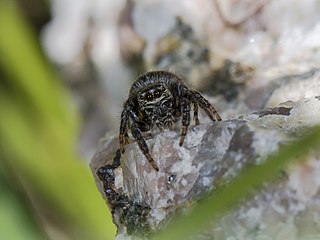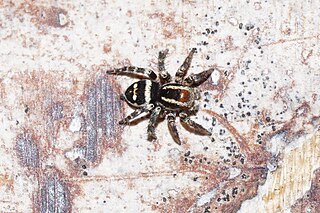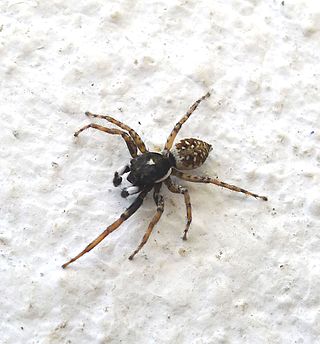
Menemerus zimbabwensis is a species of jumping spider in the genus Menemerus that lives in South Africa and Zimbabwe. The Polish arachnologist Wanda Wesołowska first described the female in 1999 and the male in 2007. The spider is large, with a cephalothorax that is between 1.9 and 3.2 millimetres long and an abdomen that is between 2.1 and 4.6 millimetres in length. The female is larger than the male. It also lacks the light stripe down the centre of its dark brown carapace and has a less distinct pattern on its abdomen. Its legs and pedipalps are yellow, while on the male they are brown. The male can be distinguished from the similar Menemerus nigli by the wide stripe on its abdomen. The female is harder to identify without looking at its copulatory organs. These are distinctive. It has characteristic large entrance bowls on its epigyne, which are larger than the insemination ducts and spermathecae combined. Its internal organs are very sclerotized.

Evarcha russellsmithi is a species of jumping spider in the genus Evarcha that lives in Ethiopia. The species was first described in 2008 by Wanda Wesołowska and Beata Tomasiewicz. The spider is small to medium-sized, with a cephalothorax measuring typically 2.2 mm (0.09 in) long and an abdomen 1.8 mm (0.07 in) long. The carapace is yellowish with dark rings around the spider's eyes. The abdomen is brown with an indistinct pattern of spots and lines. The legs are generally brown. The copulatory organs are distinctive. The male has a projection, or apophysis, from the palpal tibia that is has a series of tooth-like features, and a very short embolus that is attached to another very small apophysis. The female has multi-chambered spermathecae and distinctive accessory glands.

Hasarius insularis is a species of jumping spider in the genus Hasarius that lives on Socotra Island, Yemen. It was first described in 2002 by Wanda Wesołowska and Antonius van Harten. The spider is medium-sized, with a carapace that measures typically 4.5 mm (0.18 in) in length and an abdomen that is typically 5.9 mm (0.23 in) long. It has a cephalothorax that is mainly reddish-brown on top and yellowish on the bottom. The abdomen has dark topsides with a yellowish pattern and dark dots and patches underneath. It has copulatory organs that are similar to other species in the genus. The insemination ducts are relatively short and the spermathecae spherical, but they are both thicker than those found in other examples. The spider's name recalls a Latin word that means "insular".

Evarcha maculata is a species of jumping spider in the genus Evarcha that lives in Guinea, Ivory Coast and Ethiopia. It thrives in savanna, particularly in the Guinea Highlands and near bodies of water like the Awash River. The species was first described in 2002 by Christine Rollard and Wanda Wesołowska. The spider is small, with a cephalothorax measuring between 1.7 and 2.3 mm long and an abdomen that is between 1.6 and 3.6 mm long. The female is generally larger than the male, although there are exceptions, particularly amongst those found in Guinea. The cephalothorax has a yellowish topside, or carapace, with a darker eye field, and an yellow or yellowish-orange, or sternum. The abdomen has a distinctive pattern that is basically shaped like a capital "H", referred to in the species name, which can be translated "spotted". The spider has orange or yellow legs. It has distinctive copulatory organs. The female has distinctively shaped insemination ducts. The male has a very short curved embolus.

Evarcha grandis is a species of jumping spider in the genus Evarcha that lives in Nigeria. The species was first described in 2011 by Wanda Wesołowska and Anthony Russell-Smith. It is larger than typically for the genus, which is reflected in the species name derived from the Latin word that means "large". The spider has a cephalothorax that is typically 3.6 mm (0.14 in) long and an abdomen 5.7 mm (0.22 in) long. It has a brown carapace with a black eye field and greyish-brown abdomen. It has long brown bristles on its clypeus, or face, and white lines on its cheeks. The spider's legs are dark brown. Apart from its size, the spider's copulatory organs are the most clear way to identify it. The female has pockets towards the midpoint, rather than the rear, of its epigyne, short insemination ducts and large spermathecae. The male has not been described.

Evarcha idanrensis is a species of jumping spider in the genus Evarcha that lives in Nigeria. It is named after Idanre Hill in Ondo State, where it was first found. The species was first described in 2011 by Wanda Wesołowska and Anthony Russell-Smith. The spider is hard to distinguish from other spiders in the genus. It has a cephalothorax measuring between 2.1 and 2.5 mm long and an abdomen between 2.2 and 3.5 mm long. It has a yellow carapace with a black eye field and light brown legs. The abdomen is brownish-grey with an indistinct pattern on its back. Apart from the size of the epigyne, the female's copulatory organs are similar to other members of the genus. The male has not been described.

Evarcha picta is a species of jumping spider in the genus Evarcha that lives in Yemen. The species was first described in 2007 by Wanda Wesołowska and Antonius van Harten. The spider is small, with a carapace that measures between 2.4 and 2.6 mm long and an abdomen that is between 2 and 2.4 mm long. It has a distinctive pattern on its abdomen that is recalled in its name, which can be translated "patterned", which includes a series of white dots and chevrons. The pattern is less clear on the female than the male. Otherwise, the spider is generally brown and yellow. The male's legs are brown and yellow while the female's are yellow. There is a characteristic fovea, or indentation, in the centre of the carapace. It has distinctive copulatory organs. The female has a large depression in the centre of its epigyne and narrow insemination ducts that lead to long accessory glands and small spermathecae. The male has a terminal apophysis that makes it look as if its embolus has two branches. The spider's brownish-orange clypeus is also an identifying trait.

Euophrys kawkaban is a species of jumping spider in the genus Euophrys that is endemic to Yemen. The species was first described in 2007 by Wanda Wesołowska and Antonius van Harten. It is a very small spider, with a body that consists of a carapace, the hard upper part of the cephalothorax, that is typically 1.7 mm (0.07 in) long and 1.3 mm (0.05 in) wide and an abdomen that is typically 1.5 mm (0.06 in) long and 1.1 mm (0.04 in) wide. The carapace is yellowish, marked with a pattern of brown wedges, with a dark brown eye field. The underside of the cephalothorax, or sternum, is yellowish-brown. The abdomen has a pattern of yellowish-white and brownish-black spots that, at times, look like a series of waves. The spider's clypeus is unusual, being yellowish-brown with a covering of white hairs, which clearly differentiates the species from the related Euophrys flavoater. The male's copulatory organs, including its long and thin embolus, also helps distinguish the species. The female has not been described.

The Fayda Jumper or Afraflacilla fayda is a species of jumping spider in the genus Afraflacilla that lives in the United Arab Emirates. The spider was first described in 2010 by Wanda Wesołowska and Antonius van Harten. The spider is small, with an cephalothorax that is typically 1.8 mm (0.07 in) and an abdomen typically 2.9 mm (0.11 in) long. The female has a distinctive design on its abdomen that includes a pattern of an indistinct light patch in the centre and two light patches to the rear on a greyish-beige background, darker to the end. In comparison, the carapace is a uniform brown with a darker brown eye field. The spider's legs are yellow, the first legs being larger and featuring stridulatory apparatus. It has distinctive copulatory organs. The female has long winding insemination ducts and large spermathecae. The male has not been described.

Stenaelurillus brandbergensis, synonym Mashonarus brandbergensis, is a species of jumping spider in the genus Stenaelurillus that lives in Namibia. It was first described in 2006 by Wanda Wesołowska and placed in the genus Mashonarus but was moved to its current genus in 2018. The spider is medium-sized and black, with a cephalothorax between 1.7 and 2.0 mm in length and an abdomen between 1.6 and 2.9 mm long. It is distinguished from other members of the genus by having two broad white stripes that mark both the abdomen and carapace. The epigyne in the female also has shorter insemination ducts than the otherwise similar, though larger, Stenaelurillus guttatus.

Euophrys nana is a species of jumping spider in the genus Euophrys that is endemic to South Africa. The species was first described in 2014 by Wanda Wesołowska, Galina Azarkina and Anthony Russell-Smith. It is a small spider, with a body that consists of a cephalothorax that is typically 1 mm (0.04 in) long and an abdomen that is typically 1.5 mm (0.06 in) long. The carapace, the topside of the cephalothorax is brown a central yellow stripe. The underside of the cephalothorax, or sternum, is yellowish-brown. The abdomen has a distinctive pattern of brown and white stripes around its entire body. It is this pattern that differentiates the spider from related species. The copulatory organs are also unique amongst spiders in the genus, particularly the very long thin embolus on the palpal bulb of the male. The female has not been described.
Yimbulunga foordi is the type species of the genus Yimbulunga. It is a species of jumping spider species that lives in South Africa. The male was described in 2014 by Wanda Wesołowska, Galina Azarkina and Anthony Russell-Smith. The female has not been identified. The spider is very small, with a carapace that is 1.8 mm (0.071 in) long and an abdomen 1.4 mm (0.055 in) long. Both the carapace and abdomen are rounded, which is reflected in the genus name, the Zulu word for spherical. The species is named for the arachnologist Stefan Foord. The pedipalps are brown with a small lobe on the palpal bulb and a thin embolus that coils all the way round. The shape of the embolus and the overall stout shape of the spider differentiate the species.

Chalcoscirtus picinus is a species of jumping spider in the genus Chalcoscirtus that has been only found in the United Arab Emirates. The spider was first described in 2011 by Wanda Wesołowska and Antonius van Harten. It is a small spider, with a cephalothorax typically 1.4 mm (0.06 in) long and an abdomen typically 2 mm (0.08 in) long. It is hard to tell externally from other spiders as it is similar in size to others in the genus and, like many others, lacks a distinctive pattern on its body. Its carapace is generally greyish-brown with a black eye field while its abdomen is blackish-grey. The spider's copulatory organs. are its most distinguishing feature. The female has a small window made of membrane in the middle of its epigyne, which is narrower than that found in other species in the genus. The male has not been described.

Stenaelurillus fuscatus is a species of jumping spider in the genus Stenaelurillus that lives in Kenya and Tanzania. The species was first identified in 2000 by Wanda Wesołowska & Anthony Russell-Smith, and named for the Latin word for darkish. The spider is medium-sized with a carapace between 2.5 and 3.2 mm long and an abdomen that is between 2.8 and 3.6 in in length. The female carapace is dark brown and has two white stripes and a pattern of a triangle and spots on the abdomen. The colouration is similarly dark but the patterns are less clear. The male abdomen is dominated by a dark scutum. The female is also darker overall, with brown rather than the yellow spinnerets and light brown chelicerae of the male. The male has a hook near the base of the embolus that differentiates it from other species in the genus, while the female's wide insemination ducts sets it apart from the similar Stenaelurillus darwini.

Stenaelurillus mirabilis is a species of jumping spider in the genus Stenaelurillus that lives in Kenya and Tanzania. It was first described in 2000 by Wanda Wesołowska and Anthony Russell-Smith. The spider is medium-sized, with a dark brown carapace between 1.75 and 2.7 mm in length that has two white stripes across its length and a black abdomen between 1.9 and 2.8 mm long. The female abdomen has orange sides and a white marking of a single stripe interrupted by other marks. The male abdomen has a white cross shape formed of five spors. It is distinguished from other members of the genus by the male's long, thin palpal bulb and the female's epigyne with its short and slightly bent insemination ducts.

Stenaelurillus kavango is a species of jumping spider in the genus Stenaelurillus that lives in Namibia. It was first described in 2014 by Wanda Wesołowska from a holotype specimen found in the Kavango Region, after which it takes its name. Only the female has been identified. The spider is small, with a brown cephalothorax 2.8 mm (0.11 in) long and an abdomen 3.1 mm (0.12 in) long. The carapace is hairy, dark brown, and has four white streaks, while the abdomen is brown-black with light stripes. It can be distinguished from other members of the genus by the design of the epigyne, which is oval, and its bean-shaped spermathecae.

Stenaelurillus latibulbis is a species of jumping spider in the genus Stenaelurillus that lives in Democratic Republic of the Congo and Zambia. It was first described in 2014 by Wanda Wesołowska. The spider is medium-sized, with a dark brown cephalothorax between 2.6 and 3.0 mm in length and a black abdomen between 1.9 and 3.4 mm long. The male carapace has patches of white hairs, while the female is marked by two white stripes that stretch from the front to back. The female abdomen has a triangular-shaped white marking. It is distinguished from other members of the genus by the male's short, wide palpal bulb and the female's small epigyne with relatively short insemination ducts and round spermathecae.

Phintella occidentalis is a species of jumping spider in the subfamily Salticinae that lives in Ivory Coast. First described by Wanda Wesołowska and Anthony Russell-Smith in 2022, the species is named after the Latin word for western as it is found in West Africa. The spider is small, with a cephalothorax between 2.3 and 2.8 mm long and an abdomen that is between 3.1 and 3.5 mm long. The female is smaller than the male. The carapace is brown, the female light and the male dark. The abdomen is yellow and is marked by two wide brown stripes on the female and a grey streak on the male. It is the abdominal pattern that most clearly distinguishes the species from others in the genus. The copulatory organs are also different. The male has a longer tibial apophysis, or appendage and the female has seminal ducts that diverge and then converge.

Phintella globosa is a species of jumping spider in the genus Phintella that lives in Ivory Coast. First described by Wanda Wesołowska and Anthony Russell-Smith in 2022, the spider is small, with a cephalothorax typically 2.1 mm (0.083 in) long and an abdomen 2.0 mm (0.079 in) long. Only the female has been described. The carapace is dark brown and the abdomen yellow. Although similar to the related Phintella lucida, the copulatory organs are distinctive. The spermathecae are particularly large and spherical, which is recalled in the species name.

Menemerus niangbo is a species of jumping spider in the genus Menemerus that lives in Ivory Coast. The spider was first described in 2007 by Wanda Wesołowska and Anthony Russell-Smith. It lives in montane grasslands and shrublands.The spider is medium sized with a cephalothorax that is typically 2.6 mm (0.10 in) long and an abdomen 2.9 mm (0.11 in) long. The pear-shaped carapace is brown with a black eye field. The abdomen is dark grey with a pattern of lighter patches on top and yellowish underneath. The legs are yellowish. The spider is hard to distinguish from others in the genus without a study of its copulatory organs. Only the female has been identified. It has two distinctive pockets in the fold at the back of epigyne that is visible externally and an internal structure that includes long accessory glands and bean-shaped spermathecae.


















